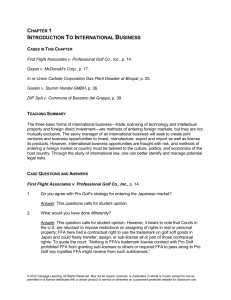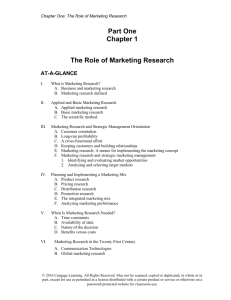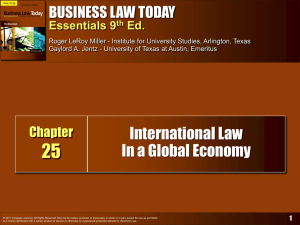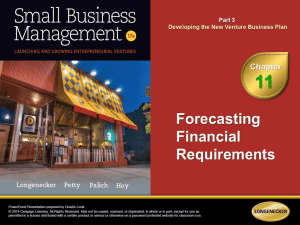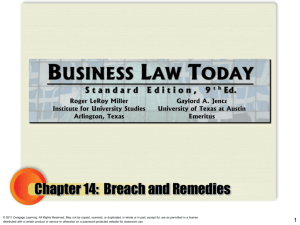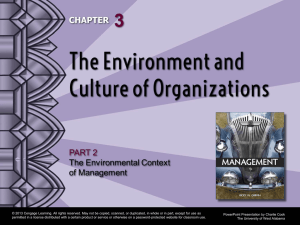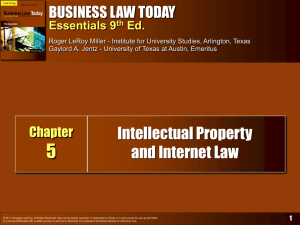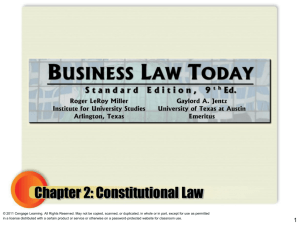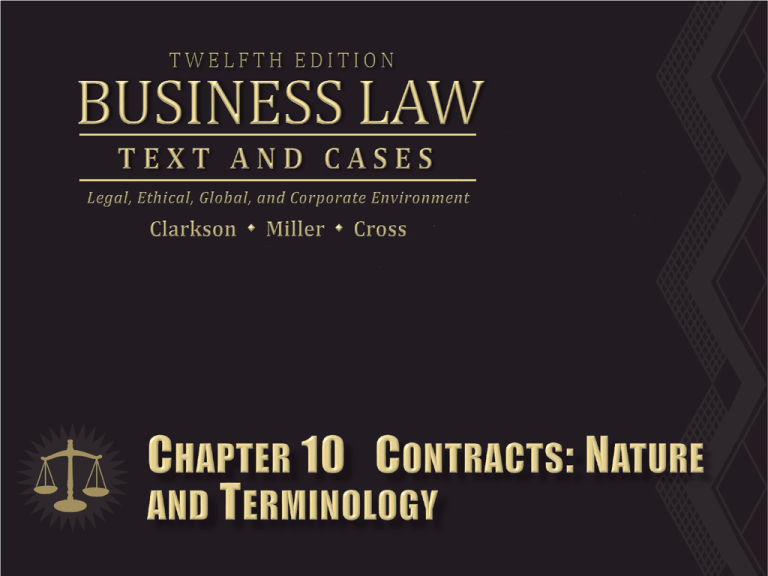
Sources of Contract Law.
Common Law for all contracts except
sales and leases.
Sale and lease contracts - Uniform
Commercial Code (UCC).
Function of Contract Law.
Provides stability and predictability for
commerce.
© 2012 Cengage Learning. All Rights Reserved. May not be copied, scanned, or duplicated, in whole or in part, except for use as permitted in a
license distributed with a certain product or service or otherwise on a password-protected website for classroom use.
2
Definition of a Contract.
Promise or set of promises,
For breach of which,
The law provides a remedy, or
The performance of which the law in
some way recognizes as a duty.
© 2012 Cengage Learning. All Rights Reserved. May not be copied, scanned, or duplicated, in whole or in part, except for use as permitted in a
license distributed with a certain product or service or otherwise on a password-protected website for classroom use.
3
Objective Theory of Contacts.
Circumstances to determine intent of
parties.
Objective Facts include:
What a party said when entering into the
contract,
How the party acted or appeared (intent may
be inferred), and
Circumstances surrounding the transaction.
© 2012 Cengage Learning. All Rights Reserved. May not be copied, scanned, or duplicated, in whole or in part, except for use as permitted in a
license distributed with a certain product or service or otherwise on a password-protected website for classroom use.
4
Agreement (Offer and Acceptance).
Consideration: bargained-forexchange.
Contractual Capacity.
Legality: purpose of contract must
be legal at the time of execution.
© 2012 Cengage Learning. All Rights Reserved. May not be copied, scanned, or duplicated, in whole or in part, except for use as permitted in a
license distributed with a certain product or service or otherwise on a password-protected website for classroom use.
5
Defenses to Enforceability:
Voluntary Consent.
Form: some types of contracts must
be in writing.
© 2012 Cengage Learning. All Rights Reserved. May not be copied, scanned, or duplicated, in whole or in part, except for use as permitted in a
license distributed with a certain product or service or otherwise on a password-protected website for classroom use.
6
© 2012 Cengage Learning. All Rights Reserved. May not be copied, scanned, or duplicated, in whole or in part, except for use as permitted in a
license distributed with a certain product or service or otherwise on a password-protected website for classroom use.
7
Bilateral - Offeree must only promise
to perform (“promise for a promise”).
Unilateral - Offeree can accept the
offer only by completing the contract
performance (“a promise for an act”).
Irrevocable: Offer cannot be revoked
once performance has begun.
© 2012 Cengage Learning. All Rights Reserved. May not be copied, scanned, or duplicated, in whole or in part, except for use as permitted in a
license distributed with a certain product or service or otherwise on a password-protected website for classroom use.
8
Formal versus Informal Contracts.
Formal: must be in writing to be
enforceable.
Informal: all other contracts.
© 2012 Cengage Learning. All Rights Reserved. May not be copied, scanned, or duplicated, in whole or in part, except for use as permitted in a
license distributed with a certain product or service or otherwise on a password-protected website for classroom use.
9
Express: Words (oral or written).
Implied (In Fact): Conduct creates
and defines the terms of the
contract. Requirements:
PL furnished good or service
PL expected to be paid
DEF had chance to reject and did not.
© 2012 Cengage Learning. All Rights Reserved. May not be copied, scanned, or duplicated, in whole or in part, except for use as permitted in a
license distributed with a certain product or service or otherwise on a password-protected website for classroom use.
10
Executed - A contract that has been
fully performed on both sides.
Executory - A contract that has not
been fully performed on either
side.
© 2012 Cengage Learning. All Rights Reserved. May not be copied, scanned, or duplicated, in whole or in part, except for use as permitted in a
license distributed with a certain product or service or otherwise on a password-protected website for classroom use.
11
Valid: agreement, consideration,
contractual capacity, and legality.
Void: no contract.
Voidable (unenforceable).
Valid contract can be avoided or
rescinded based on certain legal
defenses.
© 2012 Cengage Learning. All Rights Reserved. May not be copied, scanned, or duplicated, in whole or in part, except for use as permitted in a
license distributed with a certain product or service or otherwise on a password-protected website for classroom use.
12
© 2012 Cengage Learning. All Rights Reserved. May not be copied, scanned, or duplicated, in whole or in part, except for use as permitted in a
license distributed with a certain product or service or otherwise on a password-protected website for classroom use.
13
Quasi Contracts are implied in law.
Equitable remedy created by courts,
and imposed on parties in the interest
of fairness and justice.
Quantum Meruit.
CASE 10.1 Scheerer v. Fisher (2010).
What are the elements of quantum
meruit?
© 2012 Cengage Learning. All Rights Reserved. May not be copied, scanned, or duplicated, in whole or in part, except for use as permitted in a
license distributed with a certain product or service or otherwise on a password-protected website for classroom use.
14
Limitations on Quasi-Contractual
Remedy: enriched party is not held
liable in certain situations dealing with
benefit is conferred unnecessarily,
negligently or by misconduct.
When an Actual Contract Exists:
ordinarily no quasi-contract.
© 2012 Cengage Learning. All Rights Reserved. May not be copied, scanned, or duplicated, in whole or in part, except for use as permitted in a
license distributed with a certain product or service or otherwise on a password-protected website for classroom use.
15
“Plain Meaning” Rule: courts will
enforce contracts whose meanings
are clear from the face of the
instrument.
If terms are clear an unambiguous,
court will not admit “extrinsic”
(external) testimony or evidence.
© 2012 Cengage Learning. All Rights Reserved. May not be copied, scanned, or duplicated, in whole or in part, except for use as permitted in a
license distributed with a certain product or service or otherwise on a password-protected website for classroom use.
16
“Plain Meaning” Rule (cont’d).
However, if terms are ambiguous,
court may admit “extrinsic” (external)
evidence.
CASE 10.2 Wagner v. Columbia
Pictures Industries, Inc. (2004).
Should the court have admitted the
extrinsic evidence?
© 2012 Cengage Learning. All Rights Reserved. May not be copied, scanned, or duplicated, in whole or in part, except for use as permitted in a
license distributed with a certain product or service or otherwise on a password-protected website for classroom use.
17
Contracts are interpreted as a
whole.
Terms that are negotiated
separately given greater weight.
Words given ordinary, common
meaning.
© 2012 Cengage Learning. All Rights Reserved. May not be copied, scanned, or duplicated, in whole or in part, except for use as permitted in a
license distributed with a certain product or service or otherwise on a password-protected website for classroom use.
18
Specific wording given greater
weight than general language.
Written or typewritten given greater
weight than preprinted.
Ambiguous terms interpreted
against the drafter.
© 2012 Cengage Learning. All Rights Reserved. May not be copied, scanned, or duplicated, in whole or in part, except for use as permitted in a
license distributed with a certain product or service or otherwise on a password-protected website for classroom use.
19
Trade usage, prior dealing, course of
performance to allowed to clarify.
CASE 10.3 U.S. Bank, N.A. v.
Tennessee Farmers Mutual
Insurance Company (2009). What
does “increase of hazard” mean?
© 2012 Cengage Learning. All Rights Reserved. May not be copied, scanned, or duplicated, in whole or in part, except for use as permitted in a
license distributed with a certain product or service or otherwise on a password-protected website for classroom use.
20


